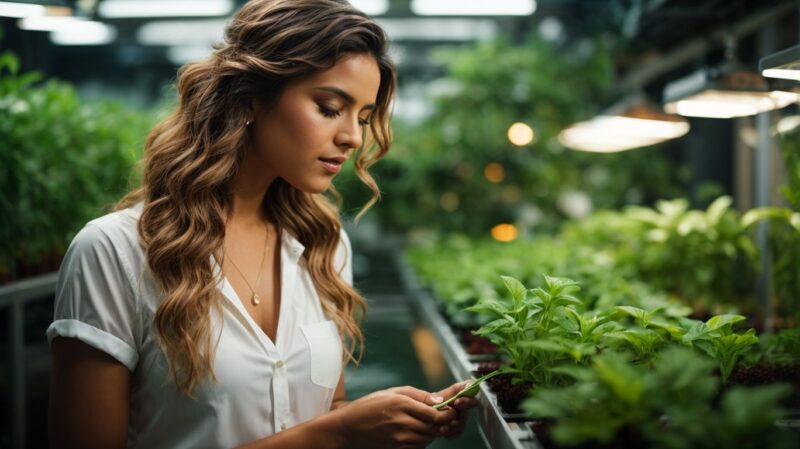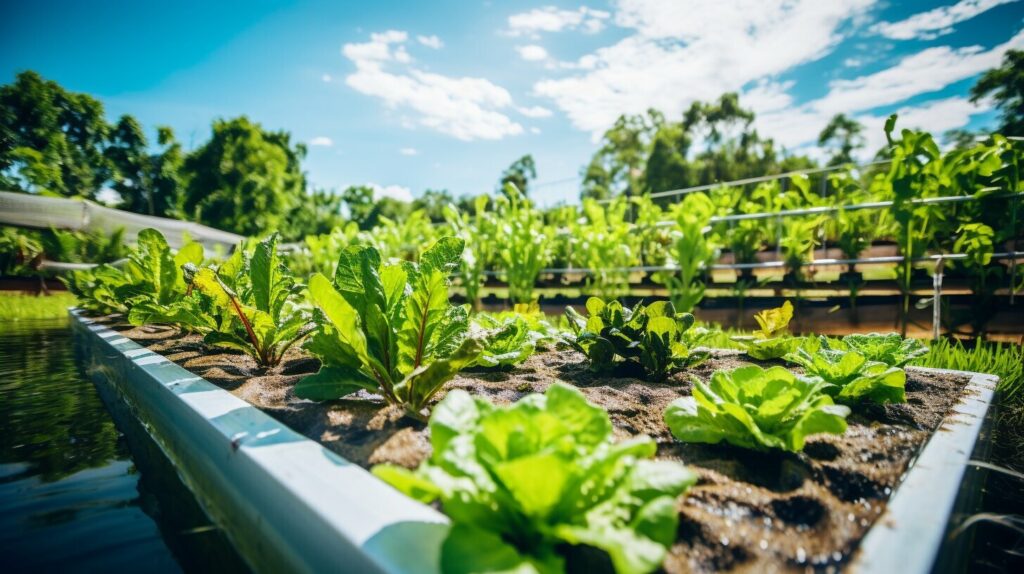This post may contain affiliate links and we may earn a small commission when you click on the links at no additional cost to you. As an Amazon Affiliate, we earn from qualifying purchases. You can read our full disclaimer here.
Welcome to the world of aquaponics! As you embark on your journey of growing plants in a symbiotic environment with fish, it’s essential to understand the criteria for effective plant selection in aquaponics. Choosing the right plants can make a significant difference in the performance and productivity of your aquaponics system.
So, what are the criteria for effective plant selection in aquaponics? Several factors come into play, such as climate suitability, growth rate, nutrient requirements, and compatibility with fish species. As you begin your aquaponics journey, remember these factors to ensure you select the most suitable plants for your system.
Effective plant selection is essential to your aquaponics system and can get overwhelming. But don’t worry. In the following sections, we will guide you through selecting plants, ensuring compatibility with your system, and maximizing your plant production. Let’s dive in!
Key Takeaways
- Climate Suitability: Choose plants well-suited to your local climate for optimal growth.
- Growth Rate: Opt for fast-growing plants to maximize yield in a shorter time.
- Nutrient Requirements: Match plant nutrient needs with your aquaponics system’s nutrient profile.
- Compatibility with Fish Species: Select plants that complement the fish in your system.
- Growing Style: Consider the space available and choose plants that fit your system’s layout.
- Grow Media Compatibility: Pick plants that thrive in your chosen grow media (e.g., gravel, clay pebbles).
- Avoid Toxic Plants: Research and avoid plants that could harm your fish.
- Optimize Water Quality: Monitor pH, dissolved oxygen, and nutrient levels for healthy plant growth.
- Maintain Proper Temperature: Keep temperatures within the ideal range for your plant species.
- Provide Adequate Lighting: Use LED grow lights to ensure plants receive sufficient light.
- Manage pH Levels: Maintain pH levels in the 6.0-7.0 range for optimal nutrient absorption.
- Practice Proper Plant Care: Regularly check for pests and diseases and provide nutrients and water.
- Start with Easy-to-Grow Plants: Beginners should begin with low-maintenance plants like lettuce and herbs.
- Experiment with Varieties: Once experienced, try different plant varieties to see what thrives in your system.
- Consider Similar Growing Conditions: Choose plants with similar climate and light preferences for harmonious growth.
- Provide Proper Care: Ensure your plants receive adequate care, addressing any issues promptly.
Understanding Aquaponics System Design
Before diving into plant selection for your aquaponics system, it’s important to understand the system’s design. Aquaponics is a recirculating aquaculture system that combines fish tanks and plant beds. The fish produce waste, broken down by nitrifying bacteria into nutrients the plants can absorb. The plants, in turn, purify the water for the fish.
The system’s design can vary, but the basics involve a pump that moves water from the fish tank to the plant beds and back again. The plant beds can be floating raft systems, media beds, or nutrient film technique systems. Each type has its benefits and drawbacks, so choosing the right one for your needs is important.
The design of your aquaponics system can impact the types of plants you can grow. For example, floating raft systems are better suited for lightweight, fast-growing plants like lettuce and herbs. At the same time, media beds can support a wider variety of plants, including fruiting plants like tomatoes and cucumbers.
Factors to Consider for Plant Selection in Aquaponics
Several factors must be considered when selecting plants for your aquaponics system to ensure their success. From climate suitability to growth rate and nutrient requirements, choosing the right plants can make all the difference in the productivity of your system. Here are some key factors to keep in mind when selecting plants for your aquaponics garden:
- Climate suitability: Consider the climate in your area and choose plants that are well-suited to your local growing conditions. This will help ensure optimal growth and yield.
- Growth rate: Look for plants with a fast growth rate, as they will be able to take advantage of the nutrient-rich water and produce greater yields in a shorter amount of time.
- Nutrient requirements: Different plants have different nutrient requirements, so it’s important to choose plants that fit well with the nutrient profile of your aquaponics system.
- Compatibility with fish species: Some plants may be better suited to certain fish species than others, so choosing plants compatible with the fish in your system is important.
- Growing style: Different plants have different growing styles, such as vining or bushy. Consider the space in your system and choose plants that will grow well, given the available area.
By considering these factors and selecting the right plants for your aquaponics system, you can maximize productivity and ensure a healthy, thriving garden. So when selecting plants, take the time to carefully evaluate your options and choose the ones that are best suited to your unique growing conditions.
Best Plants for Aquaponics
When it comes to selecting plants for your aquaponics system, there are a variety of options available to choose from. However, selecting the best plants is crucial for the success of your aquaponics garden. The right plants will help maintain the system’s health and contribute to its overall productivity. Here are some of the best plants for aquaponics:
| Plant Type | Examples | Notes |
|---|---|---|
| Leafy Greens | Lettuce, Kale, Spinach | Fast-growing, nutrient-dense, and suitable for most aquaponic setups. |
| Herbs | Basil, Mint, Cilantro | Flavorful, fragrant, and easy to grow in aquaponics. |
| Fruiting Plants | Tomatoes, Strawberries, Peppers | Requires more attention and care but can yield high-quality produce. |
These plants are popular choices because they are well-suited for the nutrient-rich water in an aquaponics system, and they can thrive in different types of grow media. Additionally, these plants can be easily maintained, harvested, and replanted for continuous yield. However, it is important to note that the selection of plants largely depends on your aquaponic setup and personal preferences.
Before selecting plants, consider climate suitability, growth rate, nutrient requirements, and compatibility with your fish species. With the right plants in your aquaponics system, you can ensure optimal growth and productivity for your plants and fish.
Matching Plant Needs with Aquaponics Nutrient Availability

When selecting plants for your aquaponics system, it’s essential to understand their nutrient requirements. Plants require nutrients like nitrogen, phosphorus, and potassium to grow and thrive. In aquaponics systems, these nutrients come from fish waste and nitrifying bacteria that convert the waste into usable forms.
You can ensure that your plants receive the necessary nutrients by matching their needs with the nutrient availability in the system. For example, leafy greens like lettuce and spinach have relatively low nutrient requirements, while fruiting plants like tomatoes and peppers have higher demands. Choosing plants suitable for your system’s available nutrient levels is crucial.
Monitoring water quality is also crucial for maintaining nutrient availability for plants. Keep an eye on pH, dissolved oxygen, and nutrient levels to ensure your plants get the right balance of nutrients. Adjusting pH levels can significantly impact nutrient availability, so testing and adjusting pH regularly is essential.
In addition to water quality, factors like temperature and lighting can also influence nutrient availability. For example, plants require more nutrients when grown in higher light intensities. Adequate lighting and optimal water and nutrient levels can lead to healthy plant growth and higher yields.
Ensuring that your plants receive the right nutrients is essential for promoting robust and healthy growth in an aquaponics system. By matching plant needs with nutrient availability and monitoring water quality, you can create an ideal environment for your plants to thrive.
Considering Fish Compatibility with Plant Selection
When it comes to selecting plants for your aquaponics system, it’s important to consider the type of fish you have in your tank. Different fish species have different waste outputs and can affect the water’s pH balance and nutrient levels.
Some fish species, like tilapia, are known for producing much waste and creating high levels of ammonia and nitrates in the water. This can be beneficial for some plants, but not all. Some plants, like lettuce, prefer low to moderate nutrient levels, while others, like tomatoes, require more nutrients.
It’s important to find a balance between the needs of your fish and the needs of your plants. Some fish species, like goldfish, are known for their adaptability and can tolerate a wider range of conditions. Others, like koi, are more sensitive and require specific water parameters.
| Fish Species | Plant Compatibility |
|---|---|
| Tilapia | Leafy greens, herbs, fruiting plants |
| Goldfish | Leafy greens, herbs, fruiting plants, root vegetables |
| Koi | Leafy greens, herbs |
It’s important to research the type of fish you have and understand their needs before selecting plants to grow in your aquaponics system. In some cases, adjusting the water’s pH levels or nutrient levels may be necessary to ensure that both the fish and plants thrive.
Remember, aquaponics aims to create a mutually beneficial system between the fish and plants. By considering the compatibility of fish and plants, you can create a healthy and productive environment for both.
Choosing Plants Suitable for Aquaponic Grow Media
One of the key factors to consider when selecting plants for your aquaponics system is the type of grow media you use. The grow media is the material that supports the plant roots and holds them in place while allowing water and nutrients to flow through. Different types of grow media have different properties that can affect plant growth, so choosing plants well-suited for the media you use is important.
Some common types of grow media used in aquaponics include:
| Grow Media | Description | Plant Suitability |
|---|---|---|
| Gravel | Coarse, rocky material | Best for plants with strong root systems |
| Expanded Clay Pebbles | Porous, lightweight clay pellets | Suitable for most plants |
| Coco Coir | Ground coconut husks | Good for plants with moderate nutrient needs |
| Perlite | Lightweight volcanic rock | Good for plants that need good drainage |
When selecting plants, consider the media you use and choose plants that are well-suited for it. For example, plants with strong root systems, like tomatoes or cucumbers, may do well in gravel or expanded clay, while plants with more delicate roots, like lettuce or herbs, may do better in coco coir or perlite.
It’s also important to ensure your plant roots have enough space to grow and absorb nutrients. Make sure to choose plants that won’t outgrow the container or bed where they’re planted, and prune them regularly to keep root growth under control.
By selecting plants suitable for your growing media, you can help ensure that your plants grow strong and healthy, maximizing their productivity in your aquaponics system.
Avoiding Plants Toxic to Fish in Aquaponics
One of the most critical factors to consider when selecting plants for your aquaponics system is their potential toxicity to fish. Certain plants can release toxins that harm or even kill fish, harming your system’s health and stability. Some common toxic plants to fish include azaleas, daffodils, and foxgloves.
When selecting plants for your aquaponics system, it’s essential to research their toxicity and avoid any that could be harmful. You can find a toxic plant list online or consult an aquaponics expert for guidance.
It’s also important to note that not all fish species are equally susceptible to plant toxins. For example, tilapia and catfish are more tolerant of certain toxins than other species. Still, it’s best to err on the side of caution and avoid any potentially toxic plants altogether.
Plant selection is a critical component of aquaponics, and avoiding toxic plants is a crucial step in ensuring the health and longevity of your system. Be sure to research your plants thoroughly and choose only those safe for your fish.
Factors Influencing Plant Production in Aquaponics

It’s important to understand the factors influencing their production when growing plants in an aquaponics system. By optimizing these factors, you can ensure that your plants grow to their fullest potential and maximize the system’s benefit.
Water Quality
Water quality is one of the most crucial factors in aquaponic plant production. Ensure the water in your system is free from harmful chemicals or contaminants and has the appropriate pH level and nutrient balance for the types of plants you’re growing. Testing your water regularly with a pH and nutrient testing kit can help ensure the water quality is optimal for plant growth.
Temperature
Plants grow best in a specific temperature range, which varies depending on the type of plant. Generally, most plants thrive in temperatures between 70-80 degrees Fahrenheit. Monitor the temperature in your aquaponics system and adjust it as necessary to optimize plant growth.
Lighting
Plants require adequate lighting to grow; you’ll need to provide that lighting in an indoor aquaponics system. LED grow lights are a popular choice for indoor aquaponics gardens, as they are energy-efficient and provide the full spectrum of light that plants need to thrive. Inspect your lights correctly and adjust their intensity to ensure your plants receive the right light for optimal growth.
pH Levels
pH levels are an important factor in plant growth, and it’s important to monitor them regularly. Most plants grow best in a pH range of 6.0-7.0. If the pH levels in your system are too high or low, it can adversely affect plant growth and nutrient absorption. Adjust the pH levels as necessary to ensure optimal plant growth.
Proper Plant Care
Finally, proper plant care is key to optimizing plant production in aquaponics. This includes regularly checking for pests and diseases, pruning plants as necessary, and ensuring they receive the appropriate nutrients and water. By taking good care of your plants, you can ensure they grow to their fullest potential and benefit your aquaponics system.
Successful Plant Selection in Aquaponics
If you want to grow plants successfully in an aquaponics system, there are several factors you need to consider. By choosing the right plants, you can ensure that your plants thrive and produce a bountiful harvest. Here are some tips to help you select the plants that will grow successfully in an aquaponics system:
- Start with easy-to-grow plants: When starting with aquaponics, choosing plants that are easy to grow is a good idea. Some good options include lettuce, spinach, kale, and herbs like basil, mint, and parsley. These plants are relatively low-maintenance and can tolerate various growing conditions.
- Experiment with different varieties: Once you’ve grown easy-to-grow plants, you can start experimenting with different varieties. Try growing different lettuce or herbs to see which grow best in your system. You may also want to try growing fruiting plants like tomatoes, peppers, or strawberries.
- Choose plants that like the same conditions: When selecting plants, it’s important to choose plants that have similar growing conditions. For example, leafy greens and herbs like cooler temperatures and partial shade, while fruiting plants need more sun and warmth. By choosing plants that like the same conditions, you can ensure that your plants grow well together.
- Ensure that your plants have proper care: Aquaponic plants need proper care to grow and thrive. Ensure your plants get enough water and nutrients, and monitor their growth regularly. If you notice any signs of pests or disease, take action immediately to prevent further damage.
Following these tips, you can choose the right plants for your aquaponics system and ensure they grow successfully. Whether you’re a beginner or an experienced aquaponic gardener, selecting the right plants is essential for a successful harvest.
Conclusion: Optimize Your Aquaponics Garden with Effective Plant Selection
Congratulations! Now that you better understand plant selection in aquaponics, you’re well on your way to optimizing your garden for maximum efficiency and productivity. By choosing the right plants, you can ensure that your system provides the necessary nutrients and environment for your plants to thrive and grow.
Remember to consider the criteria discussed in this article when selecting plants for your aquaponics system. Think about the right plants for your specific system design, and make sure you’re choosing plants compatible with the fish in your tank. You’ll also want to choose well-suited plants for your chosen grow media.
It’s important to avoid selecting toxic plants for your fish and to pay attention to the many factors influencing plant production, including water quality, temperature, lighting, pH levels, and proper plant care. By doing so, you’ll be well on your way to successfully growing various plants in your aquaponics garden.
Starting with easy-to-grow plants and experimenting with different varieties can be a great way to build confidence and learn more about what works best in your system. Always monitor your plants’ health and adjust to ensure they grow to their fullest potential in your aquaponics garden.
You can grow various plants in your aquaponics system with the right approach and some experimentation. So get started today – your aquaponics garden is waiting for you!
Thank you for reading this article, and best of luck with your aquaponics gardening journey.




Pingback: Criteria for Effective Fish Selections in Aquaponics - Aquaponics Daily